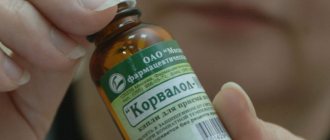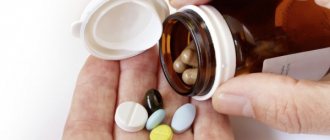- General information
- Historical facts
- Effect on the body
- How to recognize a drug addict
- Tests for barbiturates
- How long does it stay in the body?
- How long does it stay in urine?
- In blood
- In hair, nails and saliva
- How long do drug addicts live?
- Analogs
- How to speed up elimination at home
- Detoxification in hospital
- Overdose
- How to recognize
- What to do
- Rehabilitation
- Coding
- Why not at home or on an outpatient basis?
- Working with codependents and resocialization
- How to quit on your own
Attention! Drug use causes irreparable harm to health and poses a danger to life!
General information
Barbiturates are a group of powerful sedatives that depress the central nervous system. All drugs from this group are used as drugs for premedication, anesthesia or sedation for anxiety.
In medical practice, they use such a diagnosis as barbituromania. This is a condition in which a person develops physical and psychological dependence on drugs from the barbiturate group. The constant uncontrolled use of barbituric acid derivatives for the purpose of drug intoxication has led to restrictions on their sales. A replacement for barbiturates was quickly found. Instead, weaker drugs from the group of benzodiazepines are prescribed for medical purposes.
In 2021, up to 10 drugs from the barbiturate group are used. Basically, these are drugs for anesthesia that are sold by prescription. But substances such as Corvalol, with a small concentration of barbiturate, can still be bought without a prescription.
The problem with barbiturate addiction is that people often die from an overdose. Even with short-term use, memory is depressed, the ability to learn and concentrate is impaired, and irreversible changes occur in the cerebral cortex.
Basically, barbiturates are prescribed as sleeping pills 20-50 minutes before bedtime. But due to the large number of side effects, doctors began to prescribe benzodiazepine receptor antagonists.
Taken from: Pharmacology, tenth edition by D.A. Kharkevich
The main mechanism of action of barbiturates is the inhibition of spinal synaptic reflexes and the regulation of higher neuronal centers of the hypothalamus. As a result, a person loses the ability to control his emotions and coordinate his movements. High doses lead to loss of consciousness, coma and death.
Literature:
- Current classifications of medicines: textbook / [compiled by: Galustyan A. N. et al.]. — St. Petersburg: SPbGPMU, 2018. — 54 p.
- Workbook on pharmacology: workshop / Mikhail Vladimirovich Pokrovsky, Lyudmila Mikhailovna Danilenko, Tatyana Valerievna Avtina, etc.; Ministry of Education and Science of the Russian Federation, Federal State Autonomous Educational Institution of Higher Education "Belgorod State National Research University". — Belgorod: Belgorod: National Research University “BelGU”, 2018-. - 29 cm / Part 2: Workbook on pharmacology: drugs that affect the central nervous system. — 2021. — 79 p.
- Pharmacology with formulation]: textbook for medical and pharmaceutical schools and colleges: for students of secondary medical educational institutions / V. M. Vinogradov, E. B. Katkova, E. A. Mukhin. — 5th ed., rev. - St. Petersburg: SpetsLit, 2009. – 863 p.
Historical facts
The German scientist Adolf Bayer is considered the discoverer of barbituric acid. It was not until 1903 that barbituric acid derivatives began to be marketed as remedies for insomnia and stress.
The first drug to hit the market was Veronal. From 1903 to 1930, the first facts of abuse of barbituric acid derivatives were already recorded. But the lack of an alternative led to the continued use of barbiturates until the 1960s.
After studies and evidence of dependence on barbituric acid derivatives were published, these drugs were abandoned. Now barbiturates are considered illegal drugs, after taking which you cannot drive a car, do work that requires quick reactions and on which the lives of other people depend.
Content:
- What are barbiturates?
- Impact on the body.
- Potential harm and consequences of regular use. 3.1. Poisoning. 3.2. Overdose.
- Habituation and dependence.
Corvalol is a popular combination drug with a sedative and vasodilating effect. The composition, in addition to components of plant origin, includes ethyl alcohol and phenobarbital, a long-term sedative. In increased dosages, it has a drug-like effect and is addictive. So the question of whether Corvalol contains barbiturates can only be answered in the affirmative. Let's consider the occurrence of negative reactions and the consequences of prolonged use of the medication.
Effect on the body
Preparations based on barbituric acid are involved in the transformations of GABA (gamma-aminobutyric acid). They slow down the effect of the GABA neurotransmitter on synaptic membranes and, thereby, lead to partial depression of the nervous system. In turn, this activates the vagus nerve. The following reactions occur in the body under the influence of barbiturates:
- slower reaction;
- impaired coordination of movements;
- decreased heart rate;
- spasm of small and large caliber bronchi;
- acceleration of intestinal motility;
- increased salivation;
- slowing down of excitation processes in the nervous system and the appearance of drowsiness or sleep;
- memory impairment;
- decreased metabolic capacity of the liver;
- decreased intellectual abilities;
- drop in blood pressure;
- loss of the ability to control emotions.
All effects depend on dosage. Even a slight increase in the dose of the drug leads to potentiation of the effect. In pharmaceutical doses during short courses, the drug has no side effects and does not cause physical dependence.
Long-term use of even pharmaceutical doses leads to accumulation of the drug. The REM sleep phase is disrupted. Side effects after 2-4 regular doses may persist for up to 2 weeks. If a single dose exceeds the pharmaceutical dose, the following symptoms will be observed after the medication wears off:
- lethargy;
- dry mouth;
- anxiety;
- muscle twitching;
- convulsions.
If physical dependence develops (after 2 months of regular use of drugs based on barbituric acid), sudden refusal of drugs leads to mental disorders. Refusal provokes the development of psychosis, paranoid delusions, vomiting, convulsions, loss of consciousness and even death.
Over 4-6 months of regular use, the drug can lead to irreversible changes in the cerebral cortex. With physical dependence, a person practically cannot stop taking the drug immediately and without outside help.
When prescribing drugs from barbituric acid derivatives in pharmacological doses, no changes in internal organs are observed, except for allergic reactions (skin rashes, urticaria).
Taken from: Pharmacology, tenth edition by D.A. Kharkevich
The effect of the drug in small doses is similar to the effects of drinking alcohol. But if you combine barbiturates and alcohol, both substances will enhance the effect of each other. This can lead to respiratory arrest, coma, psychosis or death.
“Traps” that you can fall into when treating bronchial asthma
| Figure 1. People with asthma often have a reduced outlook for the future, although some tend to underestimate the severity of their symptoms. |
What is the differential diagnosis between asthma and COPD? What are the causes of possible diagnostic errors? What is the main role of b-agonists in the treatment of bronchial asthma? How are corticosteroids prescribed?
Despite the increased competence of doctors and the availability of effective treatments, mortality from bronchial asthma remains high. Many deaths and even most hospitalizations could be prevented with proper treatment.
It must be remembered that managing patients with asthma is a complex and lengthy process.
- Chronic bronchial asthma
Underestimation of the degree of respiratory failure. The severity of the patient’s condition and the degree of incompetence of his respiratory system may not be recognized if we neglect to carefully ascertain all manifestations of the disease and construct a diagram of measurements of the maximum flow rate (MSF) of exhaled air.
People with asthma often have reduced prospects for the future, although some tend to underestimate the severity of their symptoms. To identify such an underestimation, you need to ask the patient in detail whether he has a cough or wheezing at night or during physical activity.
If patients are unable to achieve the best possible lung function, then to correct this condition, it is necessary to first calculate the normal MSP of exhaled air for a given patient, using the chart included with the peak flow meter.
If the measured MRV is more than 20% less than the calculated one, it is worth conducting a study of the reversibility of this condition, which is done by comparing the MRV or vital capacity (VC) before and after treatment.
The necessary therapy may be as little as a single dose of a bronchodilator, but if this does not increase the MOP by 20%, the calculated level, more serious measures may be needed, such as a three-week course of systemic corticosteroids (30 mg prednisolone per day for adults). In this way, the best achievable level of MSP is determined, which is used to guide subsequent treatment.
Sometimes patients report a decrease in shortness of breath, but the MSP values do not change. In such cases, it is necessary to measure VC using a spirometer, which can confirm the improvement not determined by the MSP (Fig. 2). All doctor's offices are currently equipped with spirometers.
| Figure 2. Change in vital capacity under the influence of a course of corticosteroids. MSP may not change, but an increase in vital capacity indicates an improvement in the condition |
Bronchial asthma disguised as chronic obstructive pulmonary disease (COPD). Patients who suffer from shortness of breath and are diagnosed with COPD or emphysema may have an underlying bronchospastic element due to asthma.
Such patients should undergo a reversibility study as described above. Any improvement in lung function can be supported by adequate treatment of asthma. In the absence of improvement in pulmonary function, the use of corticosteroids is not justified, but only leads to unwanted side effects such as osteoporosis.
What a doctor should remember when observing patients with bronchial asthma |
|
Chronic use of short-acting b-agonists . Treatment of asthma with chronic use of β-agonists has been shown to increase pulmonary hyperresponsiveness and worsen bronchial asthma [1]. If a patient is using beta-agonists routinely rather than occasionally, their use should be followed by inhaled corticosteroids or, if corticosteroids are already being used, by increasing the dose sufficient to control asthma. Thus, b-agonists are reserved for cases of shortness of breath and wheezing.
The latest guidelines for the treatment of bronchial asthma in Britain recommend starting with a high dose of inhaled or systemic corticosteroids to achieve rapid control, then gradually reducing the dose to the minimum that ensures the patient feels normal and optimal values of MSP or vital capacity against the background of minimal use of a bronchodilator (Fig. 3) . The rapid relief achieved with corticosteroids improves the patient's mood and increases his confidence in treatment.
| Figure 3. It is recommended to start with high doses of corticosteroids, and then gradually reduce the dose to the minimum (optimal MRP or VC values) |
Recent evidence suggests that corticosteroids should be started as early as possible in all asthmatics, not only to control symptoms but also to prevent progressive structural lung damage caused by chronic inflammation [2,3]. This means that corticosteroids should be preferred over b-agonists once the diagnosis is confirmed by the MCP chart. β-agonists remain reserve drugs of last resort.
Possibility of alternative treatment. Although inhaled corticosteroids should be the cornerstone of asthma treatment, some other medications may be used in cases that are difficult to treat. It has been proven that theophyllines have an anti-inflammatory effect in fairly small doses, but their possible interaction with other drugs must be taken into account in each individual case.
It is advisable to prescribe ipratropium to elderly patients. Nedocromil and cromoglycate are sometimes effective.
Long-acting bronchodilators such as salmeterol may provide relief, especially at night, by blocking bronchoconstrictor mechanisms. However, it is necessary that all of the above drugs be accompanied by the use of adequate doses of corticosteroids.
Inhalation technique. It is important to ensure that patients develop proper inhaler handling skills. The doctor should help you choose the type of inhaler that is most convenient for the patient and check its performance. To do this, the doctor's office must have a full set of inhalers.
Spacers. Used in conjunction with aerosol inhalers, spacers facilitate drug penetration into the lungs and reduce both pharyngeal accumulation and systemic absorption through swallowing.
Spacers help coordinate drug release with inhalation. This is especially important when inhaled corticosteroids are used. Since corticosteroids are only used twice daily, the bulky spacer can be kept at home.
Spacers provide better accumulation of the drug in the lungs than nebulizers. It is necessary to use them correctly: shake the inhaler so that the medicine is mixed with the carrier, and inject the mixture once, followed by a quick inhalation [4].
Trigger factors. Unrecognized trigger factors can be at home, at work, or on vacation, that is, almost anywhere. Anamnesis will help identify the source. For example, with occupational bronchial asthma, the condition improves during vacations and on weekends. The absence of the irritant reduces or eliminates the manifestations of the disease and reduces the need for medications.
An often overlooked problem may be secondhand smoke. Drugs such as b-blockers and nonsteroidal anti-inflammatory drugs (NSAIDs) can also cause asthma.
- Attack of bronchial asthma
Use of nebulizers (nebulizers) without background corticosteroid therapy. When treating an acute asthmatic attack without oral corticosteroids, nebulizers are still used, which deliver a higher dose of beta-agonists. This does relieve bronchospasm, but since a high dose of b-agonists does not affect the accompanying inflammatory process, it is necessary to immediately give the patient oral corticosteroids to prevent the attack from worsening; the effect of bronchodilators decreases as swelling of the mucous membrane increases.
If the severity of the attack is such that a nebulizer is required, systemic corticosteroids should be prescribed. Even with a moderate attack, bronchodilators alone provide only temporary relief and there is a risk of a recurrence of the attack - possibly in the dead of night!
Delayed administration of oral corticosteroids. If anti-inflammatory therapy is not carried out, swelling of the mucous membrane increases in patients, which leads to recurrence of attacks. These patients often require hospitalization and high doses of corticosteroids for several days before their condition stabilizes.
Patients susceptible to rapid-onset attacks require corticosteroids and bronchodilators as early as possible. They must be able to recognize worsening conditions, have corticosteroids on hand at all times, and know how to use them. These patients should not be forced to wait for a physician to see them (Figure 4).
| Figure 4. Dependence of the development of acute attacks on the time of administration of corticosteroids and as a result of the use of long courses of systemic corticosteroid therapy. (1) Corticosteroids are prescribed immediately after the attack occurs: recovery occurs quickly. (2) Corticosteroids given after 6 hours: recovery delayed. (3) Corticosteroids are prescribed after 12 hours: the attack is severe and prolonged, recovery is slow |
Patients with gradual onset of attacks may want to wait and see if an increased dose of inhaled corticosteroids combined with a bronchodilator helps.
Inadequate course of systemic corticosteroids. Sometimes prescribed corticosteroids are canceled until the attack is completely relieved, which leads to continued bronchial hyperreactivity and another attack.
Such a chain of events can lead the patient to the false conclusion that he has bronchial asthma, which is difficult to treat.
The situation can be corrected by a long course of corticosteroids, continuing for several days after the condition has stabilized, and gradually reducing their dose until the minimum maintenance level is reached.
Stop monitoring the patient after an acute attack or hospitalization. Difficulties arise when discontinuing a systemic corticosteroid and prescribing an inhaled one. During this transition period, careful monitoring is necessary; Once the condition has stabilized, the dose of inhaled corticosteroid is gradually reduced to the minimum required so that the disease does not manifest itself and pulmonary function is optimal.
The goal of subsequent treatment is to maintain the highest SMR achieved in the hospital after a course of systemic corticosteroids.
A consultation some time after discharge provides a good opportunity to review the patient's management plan, find out what is wrong, and make appropriate adjustments.
- Differential diagnosis
Coughing and wheezing with purulent sputum is sometimes mistaken for a lung infection. However, the sputum of asthmatic patients contains much more eosinophils than polymorphic cells and bacteria. In old age, left ventricular failure and cardiac asthma should suggest preexisting bronchial asthma. Be careful with b-blockers!
Sudden shortness of breath may be due to pneumothorax or pulmonary embolism. Wheezing occurs with pulmonary tuberculosis, bronchial carcinoma, or a foreign body and can be clearly localized. Therefore, a chest x-ray should be performed in any patient with adult-onset asthma.
- Priority measures
After making a diagnosis, the doctor’s main goal is to free the patient from the manifestations of the disease and optimize lung function, as well as establish control over the disease. To do this, specially trained medical personnel must educate patients and check that they are following all instructions correctly.
Of course, in some cases this may be difficult, but the vast majority of patients can master the prescribed action plan.
All patients must:
- be able to recognize the onset of an attack
- know how to use high doses of b-agonists;
- start taking prednisolone orally on your own;
- know when to call the doctor or go to the hospital;
- Anyone suffering from attacks should be provided with corticosteroids.
References
1. Sears MR, Taylor DR et al. Regular inhaled b-agonist treatment in bronchial asthma. Lancet 1990;336:1491–1396. 2. Tari Haahtela et al. Comparinson of terbutaline with budesonide in newly detected asthma. N Engl J Med 1991;325:388–392. 3. Redingon AK, Howarth PH Airway remodeling in asthma. Thorax 1997;52:310–312. 4. O'Callaghan C., Barry P. Spacer devices in the treatment of asthma. BMJ 1997;314:1061–1062.
Spirometry for chronic bronchial asthma
A barrel chest in chronic bronchial asthma occurs due to air retention in the peripheral parts of the lungs, which leads to constant maintenance of the chest in a state of inspiration. The trapped air is not exhaled and uselessly occupies most of the lungs (residual volume). This reduces the volume of air (vital capacity) entering the lung.
Air is retained due to chronic inflammation, causing swelling of the lining of the peripheral bronchioles. When treated with corticosteroids, the swelling subsides and air is released. This is proven by an increase in vital capacity determined spirometrically. MSP may not change (see Fig. 2.)
Note!
Asthma attack
- Promptly initiate corticosteroid therapy if asthma is so severe that it requires the use of bronchodilator nebulizers
- Patients prone to frequent attacks should have their own supply of corticosteroids and know how to use them
- Every asthmatic patient should have a written plan for managing their condition.
Chronic asthma/COPD
- Every patient must undergo an allergy test
- Use an adequate dose of corticosteroids to prevent bronchodilator dependence
- Use bronchodilators only to stop an attack
How to recognize a drug addict
When abusing barbiturates, a person can be in two states: the state of drug action or intoxication, and the state of withdrawal. In the first case there will be the following symptoms:
- lethargy and slow reaction;
- impaired coordination of movements;
- difficulty concentrating;
- disorientation in space and time.
A person under the influence of barbiturates usually wants to be left alone. The drug's action phase ends with deep sleep.
The state of intoxication resembles alcohol intoxication, but unlike the latter, when intoxicated with barbiturates, there is no smell of ethanol from the patient’s mouth.
In a state of withdrawal, a person may experience psychosis, paranoia, and anxiety. The desire to use in order to eliminate all symptoms prevails over other vital needs in the form of food, communication, personal care (hygiene, clean clothes, favorable living environment).
In a state of withdrawal, a person is able to deceive family and friends. He may steal money or valuables from the house. If there is a suspicion that a person is abusing drugs based on barbituric acid, it is necessary to test the patient.
Contraindications
Corvalol is available from pharmacies without a doctor's prescription, and some patients take it in dosages significantly higher than normal. This attitude towards one’s health is extremely undesirable, because many patients do not suspect how dangerous Corvalol really is.
Contraindications of the drug mainly concern components in its composition such as bromine, ethanol and phenobarbital. It is these substances in large quantities that can cause significant harm to the health and life of the patient.
Contraindications include:
- traumatic brain injuries and their consequences;
- epilepsy;
- conditions accompanied by convulsive syndrome;
- alcohol addiction;
- age under 18 years;
- first 12 weeks of pregnancy, breastfeeding;
- severe pathologies of the liver and kidneys;
- allergy to the components of the drug.
Corvalol is strictly prohibited in the first 12 weeks of pregnancy
The medication should not be taken by patients suffering from lactose deficiency or intolerance. Corvalol with glucose is contraindicated for people with any form of diabetes.
Important! The drug should not be used in patients with severe heart failure, or if there is a risk of myocardial infarction.
Tests for barbiturates
In 2006, the Ministry of Health of the Russian Federation issued a decree that all testing of people for drug or psychoactive substance abuse must be carried out in 2 stages. The first stage is preliminary, the second is confirmatory.
The preliminary stage is not legally binding, but it helps confirm suspicions that a person is a drug abuser. For preliminary diagnosis of the presence of barbiturates in the blood, rapid tests can be used. They work using the method of thin layer chromatography or enzyme immunoassay.
To study the presence of barbituric acid metabolites in the body, urine or saliva is most often used. Express tests cost from 40 to 500 rubles. There are specific tests for barbiturates only, and there are also test tablets that can be used to immediately determine the presence of metabolites of other drugs.
Test tablets for 5-10 types of drugs are more effective in diagnosis. This is due to the fact that barbiturate drug addicts usually combine the use of 2-3 types of drugs. Knowledge about the types of drugs that the patient uses is important, since treatment for combined addictions is different.
The following methods are used for confirmatory testing:
- gas-liquid chromatography;
- gas chromatography-mass spectrometry;
- three-layer chromatography.
These methods have legal force. That is, if using any of these methods they detect drugs in the body, this analysis can be used in legal proceedings. This is important because rapid tests can give incorrect results: it is easier to deceive them by replacing urine or saliva.
In order to correctly perform the analysis, you need to know what the elimination period of drugs based on barbituric acid is.
Get help now
Do any of your relatives or friends have an addiction? Have you tried in every possible way to help, but as a result the person still returned to his past life?
You are not the first to encounter this problem, and we can help you.
We guarantee anonymity, we will persuade you to undergo treatment, and we will help you choose a center.
Call us
+7
or
Call me
How long does it stay in the body?
Drugs based on barbituric acid accumulate in the body. Because of this, they can be found in urine for 2-3 weeks. But it should be borne in mind that this only applies to drugs with prolonged action.
Those who abuse barbiturates choose fast-acting drugs. They have a more pronounced narcotic effect and are eliminated from the body 2-3 times faster.
Metabolism of barbituric acid-based substances occurs in the liver. The better the liver works, the faster the drug is removed from the body. In addition, the rate of elimination is influenced by factors such as age, weight, length of use, and combined addictions to other drugs.
How long does it stay in urine?
Rapid-acting barbiturates are excreted in the urine within 1-2 days. Residual metabolites may linger for up to 3 days. But they are difficult to detect and, as a rule, rapid tests do not show them. Long-acting drugs are excreted in the urine for up to 4 weeks. On average, they can be found in urine within 3 weeks from the date of the last dose.
In blood
In the blood, barbiturates bind to plasma proteins and can circulate unchanged for up to 3-4 days. If the dose of the drug is small, then they circulate for 1-2 days. Long-acting medications remain in the blood for up to 7 days. The optimal time for taking blood for analysis is 1-3 days after consumption.
In hair, nails and saliva
Barbiturates can be found in hair and nails within 1-2 months. But this analysis is carried out so rarely that there is no reliable information on the accuracy of these assumptions. The bottom line is that the examination of nails and hair is very financially expensive, and therefore is almost never prescribed, with the exception of a forensic medical examination.
Residues of barbituric acid metabolites can be found in saliva within 3-4 days. It all depends on individual characteristics, age, weight, experience of use.
What else is Corvalol dangerous?
Phenobarbital, which is part of Corvalol, belongs to barbiturates, which are classified as narcotic substances. When combined with alcohol, these components pose a significant threat to human health. In addition to phenobarbital, Corvalol contains ethyl alcohol. But that is not all. Bromisovaleric acid, which is also included in the drug, enhances the narcotic effect of phenobarbital. That is why Corvalol should be taken in strict accordance with the instructions, and in no case exceed the doses prescribed by the doctor, and even more so, it is forbidden to combine the medicine with alcoholic beverages.
How long do drug addicts live?
The average life expectancy of barbiturate drug addicts is 1-2 years. Death occurs more often with an overdose, which occurs due to the accumulation of the drug. This mechanism leads to narrowing of the bronchi, respiratory arrest, and a sharp decrease in blood pressure, which ultimately leads to death.
It happens that death occurs as a result of an overdose of barbiturates with the development of a coma from which the person no longer recovers. Cases have been described in which death occurred due to withdrawal symptoms. This happens if, after abusing large doses for 3 or more months, you abruptly stop taking medications.
Abuse of Corvalol for alcoholism is a road to nowhere!
Narcologists are already accustomed to using the newfangled term “barbituric” drug addiction, which arose precisely against the background of self-medication with Corvalol. When a patient abuses sedatives and hypnotics, a kind of dependence on the active psychotropic substance occurs.
The drug costs little, but the effect is so noticeable that no other sedatives can compare with it. At the same time, with the abuse of Corvalol, increasing intoxication with bromine develops, which is contained in the product of isovaleric acid processing - ethyl ester of α-bromoisovaleric acid - ethyl bromoisovalerianate.
Excess bromine leads to a lot of additional side effects, which we will discuss below. First of all, it is important to understand why Corvalol is so dangerous because of phenobarbital.
Do you have a bad habit? Call!
Analogs
According to the mechanism of action, hypnotic drugs from the group of benzodiazepines can be classified as barbiturate analogues. Among narcotic drugs, the mechanism of action is similar to opiates and ethyl.
The most common drug used to produce narcotic intoxication is Phenobarbital. Its analogues are the following:
- secobarbital;
- butalbital;
- fioricet;
- aprobarbital;
- Nembutal;
- alurat.
The list of the most common drugs used in Russia to obtain a therapeutic effect includes Barboval and Valocordin. But these drugs also lead to the formation of addiction: first mental, then physical.
How to speed up elimination at home
At home, it is possible to accelerate the elimination of barbiturates only partially. First of all, the patient is given sorbents: activated carbon, white carbon, smecta, etc. If the barbiturate was consumed within the last 30 minutes, the stomach must be rinsed before taking sorbents.
After taking sorbents, you need to take a lot of liquid: up to 3-4 liters. Physical activity cannot be given. If the dose of the drug was large and the person began to lose consciousness, do not try to remove the drug from the body on your own. This will only make the situation worse. You need to call an ambulance for emergency detoxification and symptomatic therapy.
First aid for overdose
In case of acute overdose of Corvalol, it is necessary to first perform gastric lavage. The patient is asked to drink about one liter of clean water, and then by pressing the fingers on the root of the tongue, they induce vomiting. This simple procedure should be performed at least 3-4 times in order to thoroughly cleanse the stomach of the remnants of Corvalol taken.
After gastric lavage, the patient is given one of the sorbing drugs. This could be Smecta, Enterogel, Filtrum STI or Activated carbon. They absorb Corvalol contained in the digestive tract and retain it, preventing it from being absorbed and entering the bloodstream.
In case of an overdose of Corvalol, you must try to maintain contact with the patient, not giving him the opportunity to fall asleep. If there is no severe vomiting, then it is necessary to frequently give water to the poisoned person, as this will increase the amount of urine excreted and thereby speed up the removal of Corvalol from the body.
In case of chronic overdose of Corvalol or the development of drug dependence, the first first aid is to stop further use of this drug.
Detoxification in hospital
Inpatient detoxification from barbiturates always begins with gastric lavage and a cleansing enema. If the patient's condition does not allow these manipulations, infusion therapy is prescribed to reduce blood acidity. It is believed that phenobarbitals are eliminated faster in an alkaline environment.
The second stage of detoxification in a hospital is the appointment of forced diuresis. This is possible with copious infusions and the administration of loop diuretics. An example of such drugs is furosemide. Such diuretics should not be used for more than 1-2 days. They wash out a lot of minerals from the blood plasma, and this can cause cardiac arrest.
In case of severe intoxication, hemodialysis or hemosorption is prescribed. If necessary, artificial ventilation can be performed.
Overdose
Overdose of barbiturates occurs more often when combined with alcohol. In case of isolated overdose, disruption of the central nervous system is associated with constant accumulation of the drug.
In case of an overdose, death can occur within 1-2 hours. Without medical training and the necessary knowledge, it is almost impossible to provide assistance at home.
Death due to barbiturate abuse occurs more often due to overdose. These drugs have a pronounced dose-dependent therapeutic effect. This means that if the dose is increased by only 5-10%, intoxication and overdose can occur.
How to recognize
In case of an overdose, a person loses consciousness in 80% of cases. He stops responding to external stimuli, the heartbeat is fixed at below 50 beats per minute or disappears altogether. In 95% of cases, breathing stops.
During an overdose, profuse sweating, profuse salivation, pain in the eyes, hiccups and vomiting occur. When tolerance develops, after 3-4 months of use, such symptoms no longer appear during an overdose. The patient immediately loses consciousness.
Taken from: Tiganov A.S. (ed.) ‹‹Exogenous mental disorders›› Abuse of sedative-hypnotics. Addictions caused by sleeping pills.”
Loss of consciousness and respiratory arrest are the two main signs of barbiturate overdose. If you witness such a condition, you need to start providing help. A person’s life depends on the 2-3 minutes in which resuscitation efforts need to begin.
When dependent on barbiturates, without receiving a new dose of medication, a state of anxiety, dissatisfaction, and weakness sets in. Dark thoughts, concerns, and fears appear. Long-term insomnia is alarming.
Taken from: Tiganov A.S. (ed.) ‹‹Exogenous mental disorders›› Abuse of sedative-hypnotics. Addictions caused by sleeping pills.
What to do
You need to call an ambulance right away; you can’t do without professional help. While you are waiting for the ambulance to arrive, you need to start performing mouth-to-mouth artificial respiration. You can use a cloth to prevent airborne diseases.
In parallel with artificial respiration, you need to do indirect cardiac massage. Every 30 chest compressions, it is important to take 1-2 breaths. The intensity of pressing is 120 times in 60 seconds, or 2 times per second. This must be done until the patient begins to breathe on his own.
If an overdose occurs without breathing problems and the patient partially regains consciousness, bemegride or corazol can be used as antidotes. But these analeptics are effective only in mild forms of overdose. In case of severe intoxication, prescribing such drugs can make the patient worse.
It is imperative to monitor blood pressure. The drug of choice is dopamine or norepinephrine. If arrhythmia develops, amiodarone may be prescribed.
Treatment of acute overdose involves the use of forced diuresis, rapid detoxification using infusion therapy, hemodialysis and hemosorption. It is necessary to maintain homeostasis of internal organs.
Taken from: Pharmacology, tenth edition by D.A. Kharkevich
Rehabilitation
Addiction becomes physical very quickly. This means that the nerve synapses can no longer function normally without a new dose of the drug. Therefore, with a sharp refusal of medications, withdrawal syndrome begins, which is manifested by a decrease in blood pressure, psychosis, and impaired consciousness.
Considering the high risks of death if the drug is abruptly discontinued, rehabilitation should be comprehensive and take place in a hospital.
This rehabilitation complex necessarily includes drug therapy, body cleansing, psychological support and resocialization. Effective and modern centers for recovery from drug addiction are required to work with codependent people. This complex of treatment measures allows you to achieve stable remission with minimal risk of failure.
Habituation and dependence.
Also, a negative result of systematic use includes the development of addiction, which is manifested by the desire to take the next dose. The medicine has a cumulative property; with prolonged consumption, tolerance is developed, and there is a tendency to increase the dose to obtain relief.
It is impossible to stop taking the medication on your own due to severe withdrawal symptoms. It is necessary to seek specialized drug treatment help. Addiction treatment is most effective at the early stages of addiction.
Coding
Coding is a scientifically unproven addiction treatment method. Coding is based on the use of hypnosis or suggestion methods. In practice, these methods do not produce results, because physical dependence should be treated only in combination with long-term psychological therapy and drug support.
If you are offered coding as a method of treatment for addiction, you should not contact such centers or clinics. Coding is a technique that extracts money from the patient, but does not produce results.
Treatment of addiction to Corvalol in our clinic
Treatment of addiction to Corvalol in our clinic includes examination, cleansing of the body, symptomatic treatment and treatment of concomitant diseases. This treatment of addiction to Corvalol allows you to avoid the development of complications and overcome physical withdrawal (if any).
Phenobarbital (the main active ingredient) has a cumulative effect, is practically not broken down in the body and is eliminated naturally rather slowly. Therefore, treatment of Corvalol poisoning is carried out using efferent therapy methods (plasmapheresis, hemosorption). One session of efferent therapy allows you to remove up to 70% of toxic substances.
In addition to drug treatment for addiction to Corvalol, all our patients receive psychotherapeutic assistance. Every day, psychologists and psychotherapists with clinical experience conduct group and relaxation sessions that normalize the psycho-emotional state of patients and promote a speedy return to a full life without chemical dependence.
Treatment of associated complications
Treatment of addiction to Corvalol in St. Petersburg is carried out in the hospital of our clinic, at the address: st. Marata, 78. Upon admission to the hospital with symptoms of Corvalol poisoning, an examination is prescribed by therapists, cardiologists, gastroenterologists and neurologists specializing in the treatment of somatic diseases accompanying chemical dependence. If complications are detected, a highly specialized doctor will carry out appropriate treatment in parallel.
Why you can’t undergo rehabilitation at home or on an outpatient basis
You cannot undergo rehabilitation for barbituromania at home. Remember that abrupt refusal of these drugs leads to life-threatening disorders.
Not every patient can receive adequate symptomatic therapy as an outpatient. The doctor cannot provide daily psychological support.
At home, the patient always has access to friends and potential distributors of the drug. If a patient needs to travel to a doctor for consultations, sometimes due to a long distance or laziness, he will remain at home, thereby disrupting the complex of rehabilitation measures.
Barbituromania is one of the most complex addictions. Her treatment should take place in a hospital or special clinics. This is the only way to preserve a person’s health and return him to a full social life.
Working with codependents and resocialization
Codependent people are those who are negatively influenced by the addict. Usually these are family members, children, wife or husband, parents or even neighbors. Psychological work needs to be done with such people. They need to be explained the characteristics of the disease and the principles of combating drug addiction.
Codependent people should be able to provide psychological support, and not, on the contrary, become a reason for a new breakdown. Work with codependents is also aimed at balancing relationships in the family after the patient returns from the clinic. The patient needs to create an environment in which he will not feel guilty or disadvantaged because of his problem.
Resocialization is the final and most important part of recovery from drug addiction. If the patient is not returned to society, he will have a new breakdown. Without the support of society, the patient does not feel his importance in life, he has nothing more to lose, and he returns to his addictions.
When resocializing the patient, he needs help in finding suitable work and friends. You need to teach a person to get along with other people, sometimes refuse them, and avoid conflicts. The better the patient’s social environment, the greater the chance that the person will never return to the path of drug addiction.
How to quit on your own
Getting rid of barbituromania on your own is dangerous and difficult. But if there is no other way out, then first of all you need to get rid of friends who use any drugs. It is these people who will not let you give up the bad habit.
Never replace one drug addiction with another. This makes no sense and can lead to a combination addiction.
If you decide to quit, you need to do it right away, you can’t put it off until tomorrow or another day. By delaying the decision, you will never be able to quit on your own.
Before stopping taking the drug, it is necessary to stock up on funds for symptomatic therapy. These are painkillers, blood pressure relievers, sorbents and alkaline solutions for rehydration. If possible, try to stock up on food and clean water for 10-14 days.
Psychotherapeutic assistance and selection of an analogue
If addiction to Corvalol has developed against the backdrop of stressful situations, when there was no strength to independently cope with problems and strong emotional experiences, the help of a psychotherapist is needed.
Psychotherapeutic assistance in our clinic is provided in the following forms:
- consultations;
- relaxation activities;
- trainings.
The doctor will help you get rid of internal conflicts and find a way out of difficult life situations that have caused psycho-emotional disorders, for example: depression, insomnia and sleep disorders. If necessary, the psychotherapist will select a safe analogue of the sedative and create a course of taking it.










